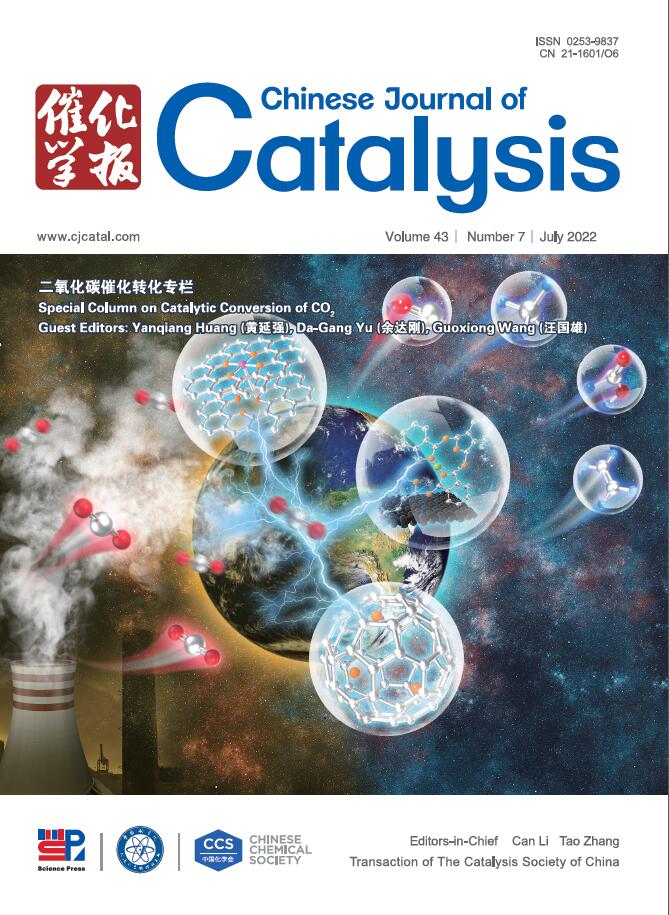碳化铁催化苯甲醇与联苯在氢气氛下的脱氧偶联
IF 15.7
1区 化学
Q1 CHEMISTRY, APPLIED
引用次数: 0
摘要
苯甲醇的直接脱氧均偶联在有机合成中建立联苯基序具有很大的前景,但在选择性和活性控制方面仍是一个巨大的挑战。本研究首次发现,以H2为还原剂,碳化铁催化剂在苯甲醇催化脱氧均偶联成联苯方面表现出较高的效率和选择性。ir -促进的Fe0@Fe5C2催化剂性能最好,各种官能团的底物均可顺利转化为联苯,产率可达85%。此外,在烯烃存在的情况下,还首次实现了醇与烯烃之间的三组分偶联反应,构建了更复杂的多环分子。自由基捕获实验和红外光谱测量分别揭示了反应的自由基性质,并显著促进了碳化后C-O键的活化。本研究将为合理设计高效、选择性的醇碳-碳偶联催化剂提供指导。本文章由计算机程序翻译,如有差异,请以英文原文为准。
Iron carbide-catalyzed deoxygenative coupling of benzyl alcohols toward bibenzyls under hydrogen atmosphere
The direct deoxygenative homo-coupling of benzyl alcohols holds great promise to build up bibenzyl motifs in organic synthesis, yet it remains a grand challenge in selectivity and activity control. Herein, we first discovered that iron carbide catalysts displayed high efficiency and selectivity in the catalytic deoxygenative homo-coupling of benzyl alcohols into bibenzyls using H2 as the reductant. Ir-promoted Fe0@Fe5C2 gave the best performance among the investigated catalysts, and a broad scope of substrates with diverse functional groups could be smoothly converted into bibenzyls, with the yield up to 85%. In addition, in the presence of alkenes, three-component coupling reactions between alcohols and alkenes were also for the first time achieved to construct more complex multi-ring molecules. The radical-trapping experiment and FTIR measurements revealed the radical nature of the reaction and the significantly promoted C–O bond activation after carbonization, respectively. This work will provide guidelines for the rational design of efficient and selective catalysts for the alcohol-involved carbon-carbon coupling reactions.
求助全文
通过发布文献求助,成功后即可免费获取论文全文。
去求助
来源期刊

Chinese Journal of Catalysis
工程技术-工程:化工
CiteScore
25.80
自引率
10.30%
发文量
235
审稿时长
1.2 months
期刊介绍:
The journal covers a broad scope, encompassing new trends in catalysis for applications in energy production, environmental protection, and the preparation of materials, petroleum chemicals, and fine chemicals. It explores the scientific foundation for preparing and activating catalysts of commercial interest, emphasizing representative models.The focus includes spectroscopic methods for structural characterization, especially in situ techniques, as well as new theoretical methods with practical impact in catalysis and catalytic reactions.The journal delves into the relationship between homogeneous and heterogeneous catalysis and includes theoretical studies on the structure and reactivity of catalysts.Additionally, contributions on photocatalysis, biocatalysis, surface science, and catalysis-related chemical kinetics are welcomed.
 求助内容:
求助内容: 应助结果提醒方式:
应助结果提醒方式:


